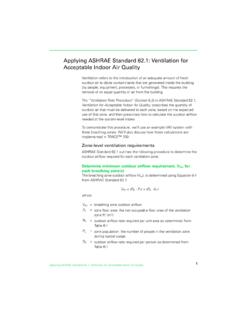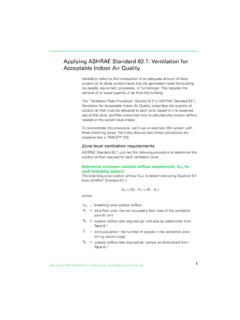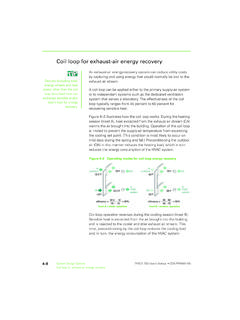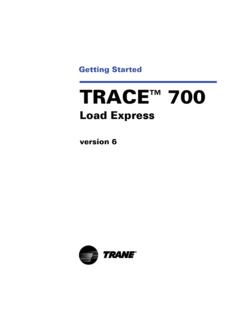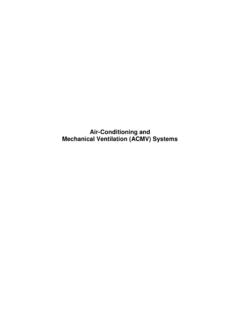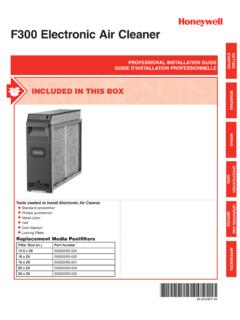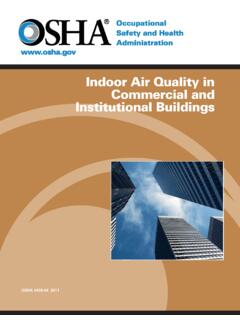Transcription of Applying ASHRAE Standard 62.1: Ventilation for Acceptable ...
1 1 Applying ASHRAE Standard : Ventilation for Acceptable Indoor Air QualityApplying ASHRAE Standard : Ventilation for Acceptable Indoor Air QualityVentilation refers to the introduction of an adequate amount of fresh outdoor air to dilute contaminants that are generated inside the building (by people, equipment, processes, or furnishings). This requires the removal of an equal quantity of air from the Ventilation Rate Procedure (Section ) in ASHRAE Standard , Ventilation for Acceptable Indoor Air Quality, prescribes the quantity of outdoor air that must be delivered to each zone, based on the expected use of that zone, and then prescribes how to calculate the outdoor airflow needed at the system-level demonstrate this procedure, we ll use an example VAV system with three breathing zones.
2 We ll also discuss how these calculations are implemented in TRACE Ventilation requirementsASHRAE Standard outlines the following procedure to determine the outdoor airflow required for each Ventilation minimum outdoor airflow requirement, Vbz, for each breathing zone(s)The breathing zone outdoor airflow (Vbz), is determined using Equation 6-1 from ASHRAE Standard = (Rp Pz) + (Ra Az )whereVbz= breathing zone outdoor airflowAz=zone floor area: the net occupiable floor area of the Ventilation zone ft2 (m2)Ra= outdoor airflow rate required per unit area as determined from Table 6-1Pz=zone population: the number of people in the Ventilation zone during typical airflow rate required per person as determined from Table 6-12 Applying ASHRAE Standard : Ventilation for Acceptable Indoor Air QualityFor this example, the required Ventilation airflow has been calculated for each zone to be.
3 These values are calculated for each room in TRACE when the Apply ASHRAE Std62-1-2004/2007 field is set to Yes on the Create Rooms - Airflows ASHRAE Standard : Ventilation for Acceptable Indoor Air QualityCalculate the zone outdoor airflowThe next step is to calculate the zone outdoor airflow (Voz), which is the outdoor airflow rate that must be provided to the Ventilation zone by the supply air distribution system. The zone outdoor airflow accounts for the zone air distribution effectiveness (Ez) found in Table 6-2.
4 The zone outdoor airflow is calculated using the following equation:Voz = Vbz / EzwhereIn this example, a VAV system supplies cool air to each zone from the ceiling, so the zone air distribution effectiveness is As a result, Voz = Ventilation requirementsASHRAE Standard also defines procedures for calculating the outdoor airflow needed at the system-level intake (Vot) to make sure that the required quantity of outdoor air is delivered to each zone (Voz). Which procedure to use depends on the configuration of the Ventilation outdoor airflowVbz=breathing zone outdoor airflowEz=zone air distribution effectiveness1To enable the ASHRAE Standard calculations at the system level in TRACE, go to Create Systems and click the Advanced ASHRAE Standard .
5 Ventilation for Acceptable Indoor Air QualityCalculate the system-level outdoor air intake flowA VAV system is a multiple-zone recirculating system, so the outdoor air intake flow is determined in accordance with Sections through of the by determining the uncorrected outdoor air intake flow (Vou) for the system by totaling the breathing zone outdoor airflow requirements from all of the spaces served by a common system using Equation 6-6. Vou = D all zones (Rp Pz) + all zones (Ra Az)where2In the System Ventilation field, select either ASHRAE Std 2004/2007 or ASHRAE Std 2004/2007 w/Vent performs the calculations behind the scenes and displays the results on the ASHRAE Standard outdoor air intakeAz=zone floor area: the net occupiable floor area of the Ventilation zone ft2 (m2)Ra= outdoor airflow rate required per unit area as determined from Table 6-1Pz =zone population.
6 The number of people in the Ventilation zone during typical usageRp= outdoor airflow rate required per person as determined from Table 6-1D=occupant diversity determined using Equation 6-7 to account for variations in population within the Ventilation zones served by the system5 Applying ASHRAE Standard : Ventilation for Acceptable Indoor Air QualityFor this example, a diversity ratio of is assumed and the uncorrected outdoor air intake (Vou) is calculated as follows:200 cfm + 300 cfm + 200 cfm = 700 cfmIf the calculations ended here, and the air handler only delivered 700 cfm of outdoor air to the occupied spaces, it is almost certain that at least one of the breathing zones would be inadequately ventilated.
7 The reason is that after the outdoor air drawn into the air handler is fully mixed with recirculated air, it is impossible to deliver discrete quantities (cfm) of outdoor air to the individual breathing zones. Instead, the supply air is delivered as a homogenous mixture of outdoor air and recirculated air, which means that all of the breathing zones receive the same percentage of outdoor determine what that percentage needs to be, the primary outdoor air fraction (Zp) must be calculated for each the primary outdoor air fraction ZpThe primary outdoor air fraction is the amount of outdoor air that must be supplied to each breathing zone as a percentage of the minimum expected primary airflow ( outdoor air and recirculated air), at design conditions, delivered to the breathing zone.
8 It is calculated using Equation = Voz / Vpz - minwhere Zp =primary outdoor air fractionVoz =zone outdoor airflowVpz min=minimum expected zone primary airflow at the design condition analyzed6 Applying ASHRAE Standard : Ventilation for Acceptable Indoor Air QualityIn the figure below, the minimum zone primary airflows have been added to the example and the primary outdoor air fraction has been calculated for each breathing zone:In TRACE 700, Vpz - min is set in the VAV Minimum Rate field on the Create Rooms Airflows tab.
9 For most systems the default value is 30%.Note: In TRACE 700, Vpz - min is also equal to the VAV minimum heating ASHRAE Standard : Ventilation for Acceptable Indoor Air QualityIn this example, 50% of the system primary air must be outdoor air to properly ventilate the critical zone. This means that all of the zones will receive 50% outdoor air and any zone with a lower primary outdoor air fraction than the critical zone will be overventilated. This overventilation results in unused outdoor air that is recirculated in the return air coming from these zones and can be used to offset the Ventilation requirements of the system Ventilation efficiency EvASHRAE Standard accounts for this unused outdoor air by means of a system Ventilation efficiency (Ev).
10 The system Ventilation efficiency may be determined using either of two methods: read the value from Table 6-3, or calculate it using the approach found in Appendix 1: Table 6-3To use Table 6-3, compare the primary outdoor -air fractions for the zones that the Ventilation system serves. Use the largest value (maximum Zp) to determine the system Ventilation efficiency. Note: For values of Max (Zp) between and , the corresponding value of Ev may be determined by interpolating the values in Table 6-3.
